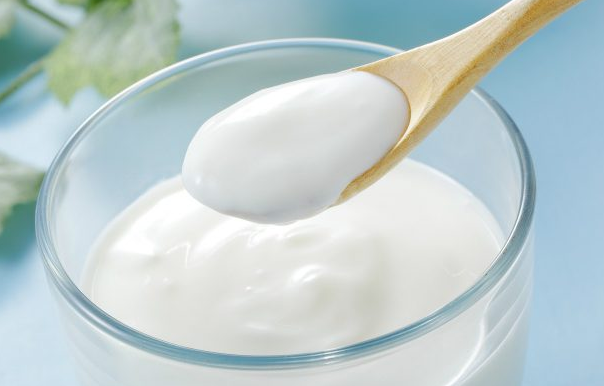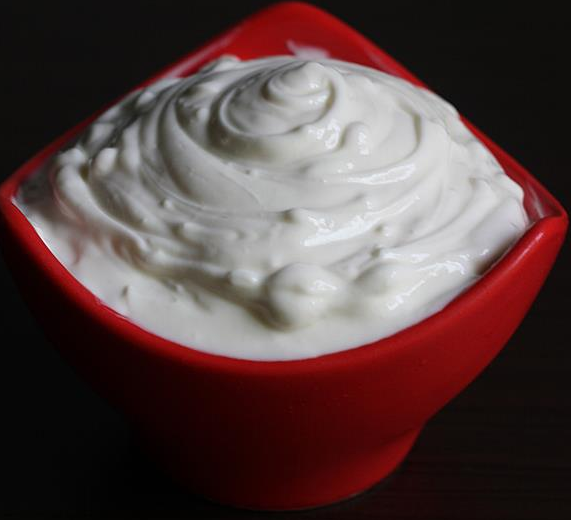Both curd and Yoghurt are dairy products. Curd is obtained by coagulating milk in a process referred to as curdling. The coagulation can happen by adding rennet or any edible acidic substance such as lemon juice or vinegar and then allowing it to coagulate. The increase in acidity makes the milk proteins (casein) to tangle into solid masses or curds. Curd products vary from one region to another and include: cottage cheese, curd cheese, farmer cheese, pot cheese, queso blanco and paneer.
Curd is normally used to enhance the taste of various foods. It is also incredibly healthy; it improves digestion, body immunity and skin health. It also improves the strength of bones and teeth.
Yoghurt is a popular dairy product obtained by bacterial fermentation of milk. To produce yogurt, milk is first heated, usually at about 85-degrees Celsius to denature the milk proteins so that they do not form curds. After heating, the milk is allowed to cool to about 45-degrees Celsius. The bacterial culture is then added and temperature of 45-degrees Celsius has to be maintained for between 3 and 12 hours to allow fermentation to occur.
It is important to note that, the bacteria used to make yoghurt are known as Yoghurt cultures. The fermentation of lactose by these bacteria produces lactic acid, which acts on milk protein to give yogurt its texture and characteristic tart flavor.
Yoghurt can be made from all types of milk. Usually, varieties made from skim milk are considered fat-free, whereas those made from whole milk are considered full-fat. More importantly, yogurt is incredibly healthy; it contains protein, calcium, minerals, and vitamins and may enhance healthy gut bacteria.

Differences between Yoghurt And Curd In Terms Of Content
Protein Content
100 grams of yoghurt contains three grams of protein whereas 100 grams of Curd contains 11 grams of protein. Also amino acids are found in plenty in both diets. Amino acids play an important role in supporting tissue health.
Fat Content
Yoghurt in its content has high amounts of saturated fats than curd. 100 grams of yogurt contain three grams of total fats, 2 grams of which is saturated fat whereas 100 grams of curd contain four grams of fat, of which two grams is saturated fat. It is important to also take note that both curd and yogurt contain a good amount of omega-3 and omega-6 fatty acids.
Also Read: Difference Between Flapjacks And Pancakes
Calorie Content
100 grams of Yoghurt contains 61 calories of which 29 calories come from fat. On the other hand, 100 grams of Curd contains 98 calorie of which 38 calories come from fat.
Carbohydrates
100 gram of Yoghurt contains five grams of carbohydrate whereas 100 grams of curd contain only three of carbohydrates. It is also important to note that sugar in the form of lactose is the main carbohydrate found in Yoghurt.
Vitamins And Minerals
Yoghurt and curd are usually regarded as a good source of essential vitamins and minerals. In comparison 100 grams of Yoghurt contains the following:
- 8% DV of riboflavin
- 6% DV of vitamins B12
- 4% DV of Pantothenic acid
- 2% DV of vitamin A, thiamin, folate and vitamin B6
- Vitamin C
- 12% DV of calcium
- 9% DV of phosphorous
- 4% DV of potassium and Zinc
- 3% DV of selenium and magnesium
- 2% DV of sodium
100 grams of Curd Contains the following:
- 10% DV of riboflavin
- 7% DV of vitamins B12
- 6% DV of Pantothenic acid
- 3% DV of vitamin A,
- 2% DV of thiamin and vitamin B6
- 8% DV of calcium
- 16% DV of phosphorous
- 3% DV of potassium and Zinc
- 14% DV of selenium
- 2% DV of magnesium
- 15% DV of sodium
- 1% DV of Copper
Taste
Curd taste slightly more tangy or sour than yogurt and may squeak against teeth while drinking it. On the other hand, lactic acid produced by the ‘’yogurt cultures’’ (bacteria) makes yogurt to have a tangy, acidic taste.
Also Read: Difference Between Dinner And Supper
Health Benefits
Medical research has shown that saturated fats from Curd may increase high-density lipoprotein (HDL) or ‘’ good’’ cholesterol and normalize blood pressure. It also contains nutrients and minerals such as potassium, calcium, phosphorus, protein, folate and vitamin B12 that are very good in strengthening bone health. On the other hand, Yoghurt contains beneficial bacteria like lactobacillus and bifidobacteria that plays an important role in maintenance of digestive health. Yoghurt also helps to neutralize the heat produced by spicy foods and helps in absorption of nutrients.
Processing
The procedure of processing Curd entails heating pasteurized homogenous milk between the temperatures of 30 to 40 degrees Celsius. The milk is then cooled then a small amount of leftover curd is added in order to allow lactobacillus to grow. This process refers to as Curdling Technique. On the other hand, the procedure of processing yogurt entails, adding bacteria cultures to milk. Lactobacillus bacteria is added to milk in order to convert lactose (sugar) into lactic acid which eventually acidifies the milk and with time the fermented milk thickens with a tangy taste of yogurt. This process is referred to as Fermentation
Flavors can be added to both curd and yogurt using fruits, sweeteners and sugar.
Preparation
Yoghurt is prepared from Soy milk, Coconut milk, Almond milk, Nut milk and milk from animals such as water buffaloes, goat, ewes, mares, yaks, camel and cows. On the other hand, curd is prepared from the milk of animals such as camel, goat, ewe, raindeer, yak, llama, water buffalo and cows.
Alternative Forms
Alternative forms of Yoghurt include Swiss style yogurt, fruit flavored yogurt etc. On the other hand, an alternative form of curd includes Lassi, buttermilk (mattha) and chaas.
Read Further: Difference Between Regular Yoghurt And Greek Yoghurt
Yoghurt Vs Curd In Tabular Form
| BASIS OF COMPARISON | YOGHURT | CURD |
| Processing | The procedure of processing yogurt entails, adding bacteria cultures to milk. Lactobacillus bacteria is added to milk in order to convert lactose (sugar) into lactic acid which eventually acidifies the milk and with time the fermented milk thickens with a tangy taste of yogurt. This process is referred to as cuddling technique. | The procedure of processing curd entails heating pasteurized homogenous milk between the temperatures of 30 to 40 degrees Celsius. The milk is then cooled then a small amount of leftover curd is added in order to allow lactobacillus to grow. This process refers to as fermentation. |
| Preparation | Yoghurt is prepared from Soy milk, Coconut milk, Almond milk, Nut milk and milk from animals such as water buffaloes, goat, ewes, mares, yaks, camel and cows. | Curd is prepared from the milk of animals such as camel, goat, ewe, raindeer, yak, llama, water buffalo and cows. |
| Protein Content | 100 grams of Yoghurt contains three grams of protein. | 100 grams of Curd contains 11 grams of protein. |
| Taste | Lactic acid produced by the ‘’yogurt cultures’’ (bacteria) makes yogurt to have a tangy, acidic taste. | Curd taste slightly more tangy or sour than yogurt and may squeak against teeth while drinking it. |
| Fat Content | 100 grams of Yoghurt contain three grams of total fats, 2 grams of which is saturated fat. | 100 grams of curd contain four grams of fat, of which two grams is saturated fat. |
| Calorie Content | 100 grams of Yoghurt contains 61 calories of which 29 calories come from fat. | 100 grams of Curd contains 98 calorie of which 38 calories come from fat. |
| Carbohydrate | 100 gram of Yoghurt contains five grams of carbohydrate. | 100 grams of curd contain only three of carbohydrates. |
| Vitamins And Minerals | 100 grams of Yogurt contains the following: 8% DV of riboflavin 6% DV of vitamins B12 4% DV of Pantothenic acid 2% DV of vitamin A, thiamin, folate and vitamin B6Vitamin C 12% DV of calcium 9% DV of phosphorous 4% DV of potassium and Zinc 3% DV of selenium and magnesium 2% DV of sodium | 100 grams of Curd Contains the following: 10% DV of riboflavin 7% DV of vitamins B12 6% DV of Pantothenic acid 3% DV of vitamin A, 2% DV of thiamin and vitamin B 68% DV of calcium 16% DV of phosphorous 3% DV of potassium and Zinc 14% DV of selenium 2% DV of magnesium 15% DV of sodium 1% DV of Copper |
| Health Benefits | Yoghurt also helps to neutralize the heat produced by spicy foods and helps in absorption of nutrients. | It also contains nutrients and minerals such as potassium, calcium, phosphorus, protein, folate and vitamin B12 that are very good in strengthening bone health. |
| Health Benefits | Yoghurt contains beneficial bacteria like lactobacillus and bifidobacteria that plays an important role in maintenance of digestive health. | Saturated fats from Curd may increase high-density lipoprotein (HDL) or ‘’ good’’ cholesterol and normalize blood pressure. |
| Alternative Forms | Alternative forms of Yoghurt include Swiss style yogurt, fruit flavored yogurt etc. | An alternative form of curd includes Lassi, buttermilk (mattha) and chaas. |
Also Read: Difference Between Micronutrients And Macronutrients
